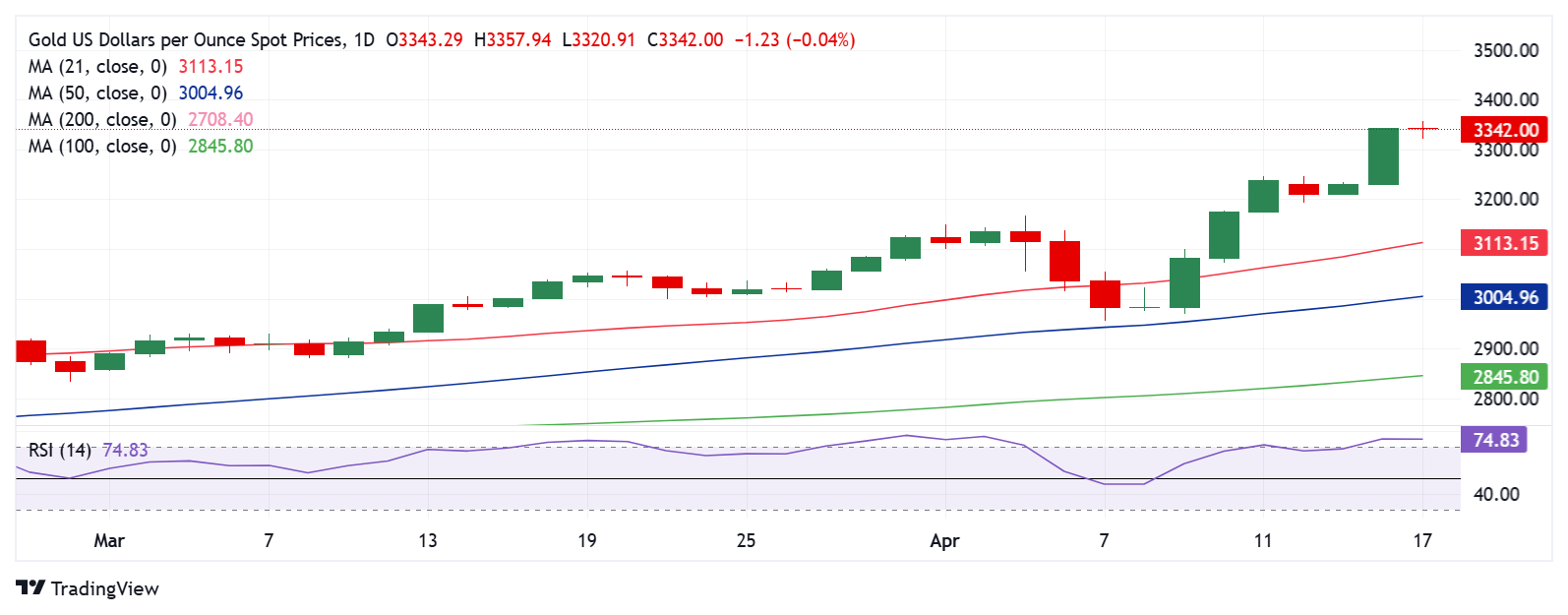- Gold price hits fresh record highs of $3,358 early Thursday, then retreats.
- US-Japan trade optimism lifts risk sentiment and the US Dollar alongside.
- Heavily overbought RSI on the daily chart continue to caution XAU/USD buyers.
Gold price has paused its record run to near the $3,360 region early Thursday as buyers digest this week’s tariff play by US President Donald Trump heading into a light Holy Friday.
Gold price could extend the pullback on profit-taking
This week, the resumption of the Gold price record-setting rally could be mainly linked to the escalation of US-China trade war and the uncertainty over US tariffs’ implementation across all its major trading partners.
Increased demand for safe-haven assets and unabated fears over a potential recession in the United States (US) continued to power Gold price advance.
“Chip stocks across the globe were pummelled on Wednesday after Dutch giant ASML warned that tariffs were increasing uncertainty around its outlook for 2025 and 2026. Also weighing on sentiment was the American artificial intelligence (AI) pioneer Nvidia warning of a $5.5 billion hit after Washington restricted exports of its AI processor tailored for China,” per Reuters.
Aggravating US-Sino trade tensions, China reportedly instructed its airlines not to take any more deliveries of Boeing Co planes, Bloomberg reported.
However, US Federal Reserve (Fed) Chair Jerome Powell’s cautious stance on the interest rate outlook and the US-Japan constructive trade talks remain a headwind for the bright metal, providing some reprieve to the US Dollar (USD).
At the Economic Club of Chicago on Wednesday, Powell said, “for the time being, we are well-positioned to wait for greater clarity before considering any adjustments to our policy stance.” Powell warned of increased stagflation risks due to the likely impact of the US tariffs.
Meanwhile, Japan’s Prime Minister (PM) Shigeru Ishiba said on Thursday that talks with the US were constructive, adding that the government will continue to consider trade negotiations a top priority.
In the day ahead, Gold price could see a corrective decline as traders might take profits off the table on their Gold longs ahead of the Good Friday holiday-thinned markets. Amid tariffs uncertainty, markets will prefer to reposition, gearing up for more tariff headlines next week.
In the meantime, the focus will remain on the meeting between Trump and Italy’s PM Giorgia Meloni, due later on Thursday. Bloomberg News reported on Tuesday that the European Union (EU) expects most of the US import tariffs to remain in place after little progress was made in the latest talks.
Meanwhile, Gold traders will also take cues from the mid-tier weekly US Jobless Claims and housing data.
Gold price technical analysis: Daily chart

The daily chart shows that the 14-day Relative Strength Index (RSI) stays heavily overbought, currently near 75, hinting at a likely correction.
However, if Gold buyers find acceptance above the $3,350 level on a daily closing basis, the next upside target will be seen at the $3,400 threshold.
Conversely, the corrective decline could initially test the $3,300 demand area, below which the $3,250 psychological level could come into play.
Further south, Gold sellers will keep sight on the $3,200 mark.
Gold FAQs
Gold has played a key role in human’s history as it has been widely used as a store of value and medium of exchange. Currently, apart from its shine and usage for jewelry, the precious metal is widely seen as a safe-haven asset, meaning that it is considered a good investment during turbulent times. Gold is also widely seen as a hedge against inflation and against depreciating currencies as it doesn’t rely on any specific issuer or government.
Central banks are the biggest Gold holders. In their aim to support their currencies in turbulent times, central banks tend to diversify their reserves and buy Gold to improve the perceived strength of the economy and the currency. High Gold reserves can be a source of trust for a country’s solvency. Central banks added 1,136 tonnes of Gold worth around $70 billion to their reserves in 2022, according to data from the World Gold Council. This is the highest yearly purchase since records began. Central banks from emerging economies such as China, India and Turkey are quickly increasing their Gold reserves.
Gold has an inverse correlation with the US Dollar and US Treasuries, which are both major reserve and safe-haven assets. When the Dollar depreciates, Gold tends to rise, enabling investors and central banks to diversify their assets in turbulent times. Gold is also inversely correlated with risk assets. A rally in the stock market tends to weaken Gold price, while sell-offs in riskier markets tend to favor the precious metal.
The price can move due to a wide range of factors. Geopolitical instability or fears of a deep recession can quickly make Gold price escalate due to its safe-haven status. As a yield-less asset, Gold tends to rise with lower interest rates, while higher cost of money usually weighs down on the yellow metal. Still, most moves depend on how the US Dollar (USD) behaves as the asset is priced in dollars (XAU/USD). A strong Dollar tends to keep the price of Gold controlled, whereas a weaker Dollar is likely to push Gold prices up.

